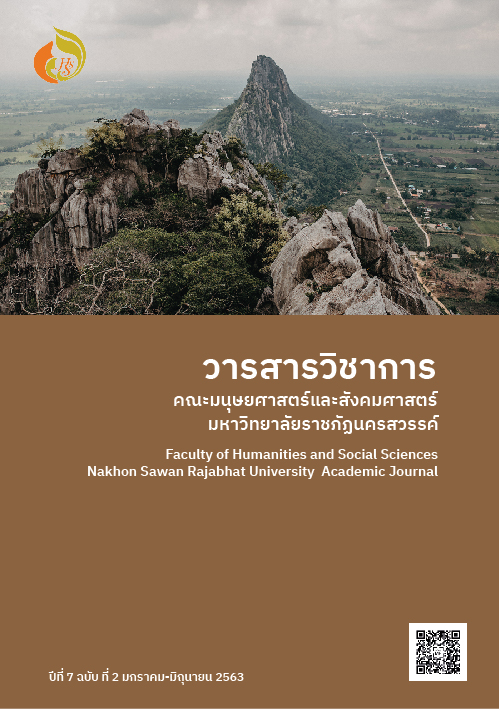Development of Local Curriculum on Bang Saphan Gold at Ban Pah Ron of Bang Saphan Witthaya School in Prachuap Khiri Khan Province Applying Participatory Action Research
Main Article Content
Abstract
The purposes of this research were to: 1) study the local knowledge on Bang Saphan gold at Ban Pah Ron, and 2) develop local curriculum on Bang Saphan gold at Ban Pah Ron of Bang Saphan Witthaya School, Prachuap Khiri Khan Province by applying participatory action research 3) study the results of experimental local curriculum on Bang Saphan gold at Ban Pah Ron of Bang Saphan Witthaya School, Prachuap Khiri Khan Province by applying participatory action research. There were 3 target groups as follows: 1) a group of community needs providers, 2) a group of local knowledge providers, 3) an experimental group for using the local curriculum. The target research area was Ban Pah Ron, Ron Thong Subdistrict, Bang Saphan District, Prachuap Khiri Khan Province. The research tools were 2 interview forms, an achievement test and a local curriculum evaluation form. The data were analyzed by using percentage, mean and standard deviation. The qualitative data were analyzed by using content analysis.
The research results were as follows: 1) The local knowledge on Bang Saphan gold at Ban Pah Ron was that Bang Saphan gold digging and sifting was first occurred during the reign of King Borommagote in 1647 in the Ayutthaya period and continued until the early Rattanakosin period. Bang Saphan gold ore was mostly found at the edges of Thong Canal and Huai Chang Han, important waterways at Ban Pah Ron, Ron Thong Subdistrict, Bang Saphan District, Prachuap Khiri Khan Province. Both waterways were geologically composed of soil, silty soil, clay and gravel. The outstanding characteristics of Bang Saphan gold at Ban Pah Ron were that it was the best gold ore in Thailand, 99% pure gold, known as "Noppakhun Neau Kao", and the gold was in the form of grain, flake, or powder. The villagers called it gold pellets and believed that it was sacred and could prevent disasters and evil spirits. The gold digging and panning of villagers in Ban Pah Ron was done by individual searcher. They did not mine it, but panned it. The gold digging and panning tools included hoes, crowbars, picks and wood saws. 2) The development of local curriculum on Bang Saphan gold at Ban Pah Ron of Bang Saphan Witthaya School, Prachuap Khiri Khan Province by applying participatory action research revealed that the local curriculum components consisted of a vision, mission, goal, course description, 4 learning units, and 8 learning management plans in 20 hours. 3) The local curriculum experiment results were that the students' learning achievement after learning was 17.03% higher than that existing before learning. The evaluation of the local curriculum showed that every element of the curriculum was in accordance with each other and the local curriculum was in accordance with the context and needs of school and community.
Article Details
References
กระทรวงศึกษาธิการ. (2553). พระราชบัญญัติการศึกษาแห่งชาติ พุทธศักราช 2542 แก้ไขเพิ่มเติม (ฉบับที่ 3) พ.ศ.2553. กรุงเทพฯ: โรงพิมพ์คุรุสภาลาดพร้าว.
กาญจนา บุญส่ง และ นิภา เพชรสม. (2556). ชุดฝึกอบรมการพัฒนาหลักสูตรท้องถิ่นและหลักสูตรสถานศึกษาที่เน้นอาเซียน. เพชรบุรี: มหาวิทยาลัยราชภัฏเพชรบุรี.
ชูชัย มีนุช. (2555). การพัฒนาหลักสูตรท้องถิ่น เรื่อง ตาลดโตนดที่บ้านไร่กร่าง ตำบลไร่สะท้อน อำเภอบ้านลาด จังหวัดเพชรบุรี โดยกระบวนการวิจัยเชิงปฏิบัติการแบบมีส่วนร่วม (วิทยานิพนธ์มหาบัณฑิต). เพชรบุรี: มหาวิทยาลัยราชภัฏเพชรบุรี.
ณภัทร ศิลปศร. (2553). การพัฒนาหลักสูตรท้องถิ่น เรื่อง สัตว์ที่อาศัยในระบบนิเวศน์ป่าชายเลน ตำบลปากทะเล อำเภอบ้านแหลม จังหวัดเพชรบุรี โดยกระบวนการวิจัยเชิงปฏิบัติการแบบมีส่วนร่วม (วิทยานิพนธ์มหาบัณฑิต). เพชรบุรี: มหาวิทยาลัยราชภัฏเพชรบุรี.
ธีรวุฒิ เอกะกุล. (2558). การวิจัยปฏิบัติการ (Action Research). อุบลราชธานี: บริษัทยงสวัสดิ์อินเตอร์ กรุ๊ป จำกัด.
นลินี ทวีสิน. (2555). การประชุมวิชาการระดับชาติ พ.ศ.2555. กรุงเทพฯ: สำนักงานปลัดกระทรวงศึกษาธิการ.
บงกชพร กรุดนาค. (2555). การวิจัยหลักสูตรท้องถิ่น เรื่อง สารสกัดสมุนไพรและปุ๋ยหมักธรรมชาติจากภูมิปัญญาท้องถิ่น ตำบลกลัดหลวง อำเภอท่ายาง จังหวัดเพชรบุรี โดยใช้การวิจัยเชิงปฏิบัติการแบบมีส่วนร่วม (วิทยานิพนธ์มหาบัณฑิต). เพชรบุรี: มหาวิทยาลัยราชภัฏเพชรบุรี.
บุญนาค ติวกุล. (2553). ชนบทไทย: การพัฒนาสู่ประชา–สังคม. นครปฐม: คณะศึกษาศาสตร์ มหาวิทยาลัยศิลปากร.
ประสาท เนืองเฉลิม. (2556). วิจัยการเรียนการสอน. กรุงเทพฯ: บริษัทวี.พริ้นท์ (1991) จำกัด.
วรรณี แกมเกตุ. (2551). วิธีวิทยาการวิจัยทางพฤติกรรมศาสตร์. พิมพ์ครั้งที่ 2. กรุงเทพฯ: โรงพิมพ์แห่งจุฬาลงกรณ์มหาวิทยาลัย.
วิจิตร ศรีสอ้าน. (2555). การประชุมวิชาการระดับชาติ พ.ศ.2555. กรุงเทพฯ: สำนักงานปลัดกระทรวงศึกษาธิการ.
ศุภลักษณ์ คำขยาย. (2559). การพัฒนาหลักสูตรท้องถิ่น เรื่อง บัวที่บ้านคลองสิบศอกของโรงเรียนวัดรังสิต จังหวัดปทุมธานี โดยใช้การวิจัยเชิงปฏิบัติการแบบมีส่วนร่วม (วิทยานิพนธ์มหาบัณฑิต). เพชรบุรี: มหาวิทยาลัยราชภัฏเพชรบุรี.
สำนักงานเลขาธิการสภาการศึกษา. (2557). รายงานการวิจัยแนวทางการพัฒนาการศึกษาไทยกับการเตรียมความพร้อมสู่ศตวรรษที่ 21. พิมพ์ครั้งที่ 2. กรุงเทพฯ: บริษัทพริกหวานกราฟฟิค จำกัด.


